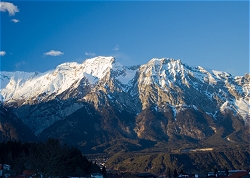
November Editorial
Are the Alps growing or shrinking?

November Editorial
Are the Alps growing or shrinking?
|
The Alps are the largest mountain range in western Europe, stretching from Austria and Slovenia across northern Italy, Switzerland and Germany into France. They were pushed up as a result of a collision between the African and Euroasian tectonic plates, when the northward-moving African landmass pushed against the stable Euroasian landmass. This process, which began approximately 55 million years ago, created a massive fold known as the Alpide belt. This originally stretched from through southern Europe and Asia from the Himalayas all the way to the Atlantic. Subsequent tectonic subsidence resulted in gaps in the Alpide belt giving rise to the separate mountain ranges we know today.
|
Crystalline basement rocks, which were exposed during the tectonic thrust in the higher central regions, gave rise to Mont Blanc (the highest mountain in the Alps, on the border between Italy and France), the high peaks in the Pennine Alps (between Italy and Switzerland) and the Hohe Tauern (the highest area of the Austrian Alps). | |
|
Today tectonic processes no longer cause changes in Alps, so as far as tectonic forces are concerned the Alps are completely stable. Nevertheless, as decades-long studies by Swiss geodesists have shown that Alpine summits rise above the lowlands by about an extra millimetre a year. Although one millimetre seems somewhat insignificant when looking at a relatively short period such as a human lifespan, over millions of years the accumulated growth should be considerable. So the question that the scientists asked was why the Alps are not much higher, and why are they growing at all? To answer this question, researchers from the German Research Centre for Geosciences looked at the extent of mountain erosion. For their studies they used the rare isotope Beryllium-10, which develops on the earth's surface via cosmic radiation. They found that they can make a direct comparison between the amount of Beryllium-10 recovered and the extent that surface has been eroded. More erosion equals less Beryllium-10 and vice versa. Their analysis concluded that the extent of erosion is approximately the same as the yearly growth of the mountains. To put it the other way, the Alps remain at the same height because growth and erosion cancel each other out. But there is one puzzle remaining. If tectonic processes are no longer involved, what causes the Alps to grow? Professor Friedhelm von Blanckenburg from the German Research Centre for Geosciences explains: 'Here pure upthrusting forces are at work. It is similar to an iceberg in the sea. If the top melts, the iceberg rises out of the water by almost the same amount'. What he means by that is that the mountains are pushed up from the Earth's mantle at the same rate as they are shrinking from the top. Imagine that you put a loaded suitcase on your bed. As you remove the contents, the mattress springs back, just as the magna of the earth's crust springs back as erosion lightens the Alps. This theory is not completely new, and scientists have postulated it for a while, but the researchers have here produced another piece of evidence in support of this theory. So it seems that, although from the tectonic point of view Alps are dead, they are actually in continuous motion and actively growing and shrinking at the same time. And what does that mean for us? Well for one thing, if global warming permits, we can probably slide down the Alpine slopes on skis for millennia to come. This article was based on the recently published joint paper from the Swiss and German camp (see below). 1. Jean-Daniel Champagnaca, Fritz Schluneggerb, Kevin Nortona, c, Friedhelm von Blanckenburga, c, Luca M. Abbühlb and Marco Schwabb. Erosion-driven uplift of the modern Central Alps. Tectonophysics, 2009, 474, pp 236-249. | |
| _______________________________ | ||||
| Home | | | Shopping | | | Database |
© Biscuit Software 2004-2015
All rights reserved